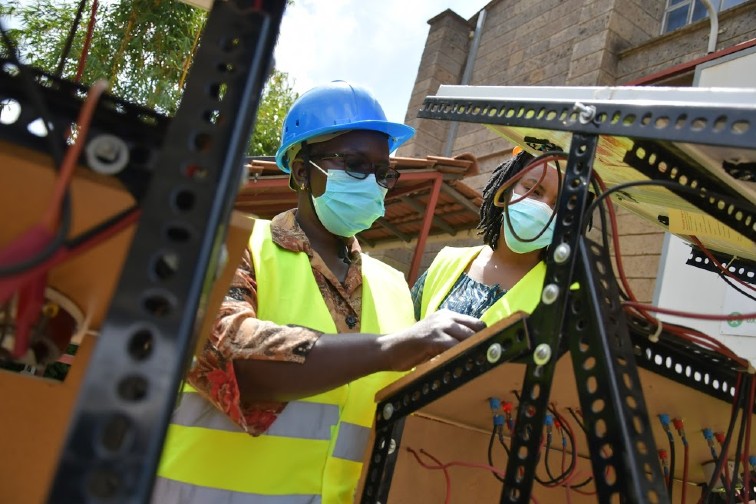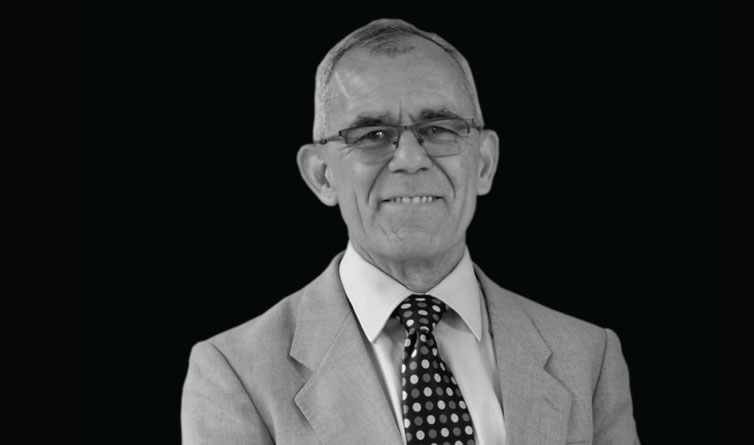Professor Da Silva is a renewable energy specialist with over 20 years of experience in research and academic leadership. He holds a PhD and a Master of Science (MSc) in Electrical Engineering, with a specialisation in Power Systems, from the University of Sao Paulo, as well as a Bachelor of Science (BSc) in Electrical Engineering, with a specialisation in Power Systems and Telecommunications, from the Federal University of Parana. He has worked on research projects with government ministries, development agencies (like GIZ, Sida, The World Bank) and industry stakeholders (within and outside Africa).
WHO HAS INSPIRED YOU THE MOST IN LIFE?
My dad. He did not go to school but he was a wise man and understood the need for education. He spent a great deal of time teaching me about business and life in general such as kindness, generosity, the need to cultivate a good relationship with God, the quest for excellence, and the importance of small things, among others. Another important thing he taught me was accountability. If I did something bad, I had to acknowledge it and face the consequences.
WHAT’S THE BEST BOOK YOU’VE READ THIS YEAR AND WHAT WAS YOUR KEY TAKEAWAY?
I read a lot. Amongst my favourites are The Lord of the Rings, Kristin Lavransdatter, Crime and Punishment, Man’s Search for Meaning, Getting things done, etc. However, there is one book which has had a great influence on my life: The Seven Habits of Highly Effective People by Stephen Covey. I have read this book about 10 times and I use it often to train people working under me.
WHEN MEETING OTHER LEADERS WHAT DO YOU ASK THEM?
I love listening to other people’s stories. I ask about their journey and what motivates them to keep going. I used to talk a lot but time has taught me that to listen is smarter.
WHAT WAS YOUR FIRST LEADERSHIP EXPERIENCE AND WHAT LESSON LEARNED DO YOU CONTINUE TO PRACTISE TODAY?
My first serious leadership experience was when I decided to leave Brazil and settle in Uganda in 1997. A new country, new language, new culture and nobody to validate me. I had a PhD in Power Systems but the country was not yet prepared to offer me an opportunity to meaningfully use my doctorate. I had to choose a new area of interest that could make an impact in society. I chose renewable energy and I never looked back. I discovered that there are many ways of doing things right, and so I had to learn to be flexible. I also learnt that one cannot go far alone, and so I had to learn to delegate and synergise.
IS A LEADER BORN OR MADE?
Both! Not everyone is called to be a leader in the sense we are considering here. My mom has never worked outside our home and yet she is a leader and, in a way, has always managed to make my dad look good. She inspired me a lot as well. There is always room for improvement and extended education. I am a passionate person who wants to learn new things until the day I die.
WHAT DO YOU THINK MAKES A SUCCESSFUL LEADER?
Humility! If one is ready to keep doing the right thing and allow the people in his/her team to shine, that person is a leader. One can learn a lot about leadership by reading Sharma’s book The Leader who Had no Title. Two other features which help are: passion and deep knowledge of whichever area one is dealing with.
WHAT INDUSTRIES OUTSIDE OF THE POWER AND ENERGY SECTOR ARE YOU LOOKING AT FOR INSPIRATION?
I love coaching and mentoring, with a keen interest in philosophy, anthropology, critical thinking and other similar areas. At Strathmore University I have a list of about ten people whom I mentor and I speak once or twice each semester. Having run seven full marathons, I am a fitness freak who keeps checking the average speed of a five- or ten-kilometer race on my fitness tracker.
WHAT’S THE BIGGEST RISK YOU’VE EVER TAKEN?
It was to go for an academic career without anyone in my family ever having gone to university. At 17 years I left my small town and job to pursue an engineering career with zero money! I learned from my father how to repair watches and with that skill, I was able to study, get a government-paid engineering degree and later another national government-supported Masters and PhD. Today many of my relatives have degrees because they were inspired by my little madness!
IF YOU COULD WISH AWAY A CHALLENGE TO YOUR BUSINESS OR THE INDUSTRY, WHAT WOULD IT BE?
One of my dreams is to coach graduate engineers to help them become registered engineers and behave in an ethical manner. I would tell each one of them that if we each commit ourselves to be a good professional who does not steal and does not lie, though we may not solve the problems of the world, for sure there will be two “thugs” less on this planet. And that would be something already! So, yes, I would wish away the complacency with corruption that so many African professionals have.
WHAT TOOLS AND TECHNIQUES DO YOU USE TO KEEP A TEAM MOTIVATED?
The main “tool” is the inside out struggle. They have to see you fighting to be better. If you are: a) proactive, b) start with the end in mind and c) put first things first, I can warrant your success as an inspiring leader. This is the lesson I learnt from the book by Covey I mentioned above. It is really a “must read” for all who want to make it in life in a holistic manner.
HOW DO YOU MEASURE YOUR AND YOUR TEAM’S PERFORMANCE?
At Strathmore University we have a biannual evaluation following up on our agreed Key Performance Indicators (KPI). This helps keep you on track as you begin working on these KPIs from the start of the year that you can split into several actionable tasks. One thing that helps is to have all the KPIs of all the people working with me aligned in such a way that natural synergy appears with amazing results. The main issue is to do things rather than talk about things. We always have in mind the importance of avoiding N.A.T.O. which is my acronym for No Action, Talk Only! NATO people must either change or be let go.
HOW DO YOU DEAL WITH UNCERTAINTY AS A LEADER IN A TIME WHERE LEADERSHIP IS MORE IMPORTANT THAN EVER?
The first rule of leadership when facing uncertainty is to “Accept Reality”. Every day things happen to us. Some are good, others are neutral, and some are bad. Accept them all. This is your raw material to achieve your success. Wishful thinking is a waste of time. For example, last year and even now, we have the COVID-19 pandemic with all its consequences. I accept COVID-19 and ask: how can COVID-19 make me a better person and how can COVID-19 help me to help other people? If because of COVID-19 I acquire some virtues and avoid some vices and if on top of it all I become more charitable and make people’s lives better, COVID-19 has done good to me!
WHAT ROLE DO YOU SEE YOUR TEAM PLAYING IN THE ECONOMIC RECOVERY OF THE 2020 GLOBAL PANDEMIC?
My institution is small (about 1,000 staff members) and is aligned with our strategic goals and values. This helped us to fast-track the training of lecturers and researchers so that they could perform their duties via the internet in a fast and highly professional manner. This made all the difference when the lockdown started. We created a suitable environment for all students to keep learning with enough bundles, laptop, administrative support and mentoring. We plan to continue working together with students, lecturers and parents to face the challenges of economic recovery. We have been organising ‘townhalls’ with all stakeholders and this has helped us to get innovative ideas and put them into practice.
HOW IMPORTANT IS SCENARIO PLANNING WHEN IMPLEMENTING ANNUAL STRATEGIES?
Without scenario planning it is impossible to develop people and institutions. Unless we know where we want to be in one year’s time, management becomes an unattainable task. I have been working with integrated reporting for eight years now. We consider development on the three P’s: People, Planet and Profits. Alignment becomes easy and the results are amazing.
WHEN WE TALK ABOUT DIGITALISATION, THE COMPLEXITIES AND INTRICACIES, WHAT ARE YOUR THOUGHTS AND FEELINGS AROUND THIS AND HOW IT WILL CHANGE THE SHAPE OF THE POWER AND ENERGY SECTOR AFRICA?
My opinion is that whoever does not see the importance of digitalisation today will have some difficulties typical of someone who is trying to do a job without suitable tools. The result is, most often than not, a disappointing one. We have to know that the future is the Internet of Things, Big Data, Smart Meters, Smart Cities, Smart Grids, Artificial Intelligence, Cloud Computing, etc. ENEL, the utility of Italy, bought 17 million connections in Brazil in 2019. They started immediately with the digitalisation of the whole system to shorten downtime and to reduce maintenance time and cost. These measures improved the financial performance of that business! Today Africa needs to train people who are able to work within this ecosystem. IBM is helping with a programme called Africa Digital Nation. It is a free platform where training is offered in the above-mentioned areas so that in 10 years’ time the young skilled people of this continent will be able to innovate not only at home but also by holding positions of high responsibility in the global arena.
WHAT DO YOU WANT YOUR LEGACY TO BE?
I want to be remembered as a man who spread joy and peace around himself and enjoyed working a lot and making friends.
I came to Africa in 1997 with my just-defended PhD. I started working in Makerere and set up a research centre called CREEC – Centre for Research in Energy and Energy Conservation. We worked a lot with GIZ, The World Bank, Sida-SAREC, the government, private sector players such as SMA, ABB, Siemens, etc. In 2010 I moved to Kenya. Here I started working in Strathmore University where we set up another research centre called SERC – Strathmore Energy Research Centre. I put a lot of work into these two research centres, and I enjoyed every bit of it as I am passionate about renewable energy and energy efficiency.
The innovations we implemented in these two countries changed, for the better, the lives of many people and instilled passion in my students and colleagues. They eventually joined me in this exciting journey of making this planet a better place and providing better living conditions for people who otherwise would not have access to reliable, affordable and clean energy. As a professional, I think I can leave behind an example of someone who is skilled, passionate and able to get things done.
This article was first published on Africa Power & Energy Elites website











